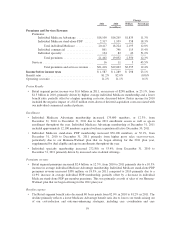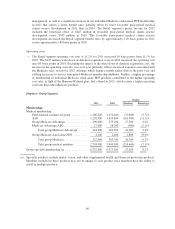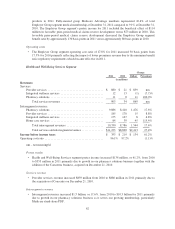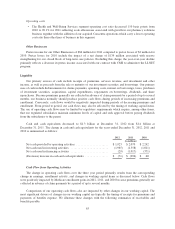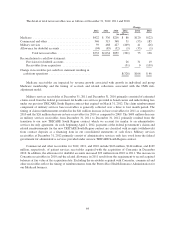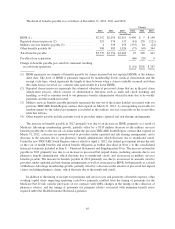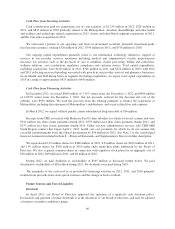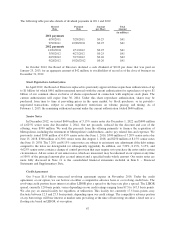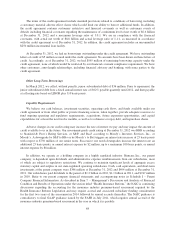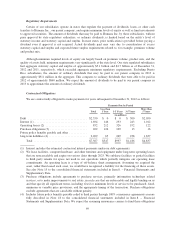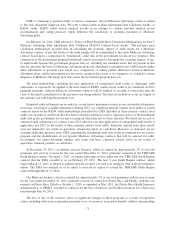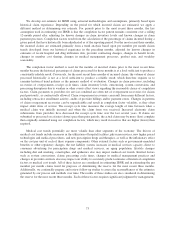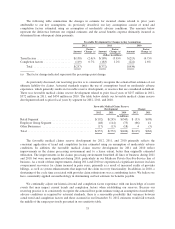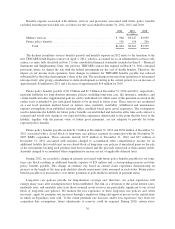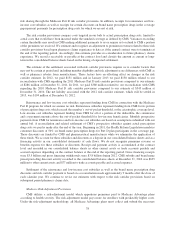Humana 2012 Annual Report Download - page 79
Download and view the complete annual report
Please find page 79 of the 2012 Humana annual report below. You can navigate through the pages in the report by either clicking on the pages listed below, or by using the keyword search tool below to find specific information within the annual report.
Regulatory Requirements
Certain of our subsidiaries operate in states that regulate the payment of dividends, loans, or other cash
transfers to Humana Inc., our parent company, and require minimum levels of equity as well as limit investments
to approved securities. The amount of dividends that may be paid to Humana Inc. by these subsidiaries, without
prior approval by state regulatory authorities, or ordinary dividends, is limited based on the entity’s level of
statutory income and statutory capital and surplus. In most states, prior notification is provided before paying a
dividend even if approval is not required. Actual dividends paid may vary due to consideration of excess
statutory capital and surplus and expected future surplus requirements related to, for example, premium volume
and product mix.
Although minimum required levels of equity are largely based on premium volume, product mix, and the
quality of assets held, minimum requirements vary significantly at the state level. Our state regulated subsidiaries
had aggregate statutory capital and surplus of approximately $5.1 billion and $4.7 billion as of December 31,
2012 and 2011, respectively, which exceeded aggregate minimum regulatory requirements. Excluding Puerto
Rico subsidiaries, the amount of ordinary dividends that may be paid to our parent company in 2013 is
approximately $911 million in the aggregate. This compares to ordinary dividends that were able to be paid in
2012 of approximately $860 million. We expect the amount of dividends to be paid to our parent company in
2013 to approximate the amount of ordinary dividends.
Contractual Obligations
We are contractually obligated to make payments for years subsequent to December 31, 2012 as follows:
Payments Due by Period
Total
Less than
1 Year 1-3 Years 3-5 Years
More than
5 Years
(in millions)
Debt ........................................ $2,550 $ 0 $ 0 $ 500 $2,050
Interest (1) .................................... 1,694 146 293 243 1,012
Operating leases (2) ............................ 852 212 326 192 122
Purchase obligations (3) ......................... 262 124 109 13 16
Future policy benefits payable and other ............
long-term liabilities (4) .......................... 2,209 65 269 238 1,637
Total .................................... $7,567 $547 $997 $1,186 $4,837
(1) Interest includes the estimated contractual interest payments under our debt agreements.
(2) We lease facilities, computer hardware, and other furniture and equipment under long-term operating leases
that are noncancelable and expire on various dates through 2025. We sublease facilities or partial facilities
to third party tenants for space not used in our operations which partially mitigates our operating lease
commitments. An operating lease is a type of off-balance sheet arrangement. Assuming we acquired the
asset, rather than leased such asset, we would have recognized a liability for the financing of these assets.
See also Note 15 to the consolidated financial statements included in Item 8. – Financial Statements and
Supplementary Data.
(3) Purchase obligations include agreements to purchase services, primarily information technology related
services, or to make improvements to real estate, in each case that are enforceable and legally binding on us
and that specify all significant terms, including: fixed or minimum levels of service to be purchased; fixed,
minimum or variable price provisions; and the appropriate timing of the transaction. Purchase obligations
exclude agreements that are cancelable without penalty.
(4) Includes future policy benefits payable ceded to third parties through 100% coinsurance agreements as more
fully described in Note 18 to the consolidated financial statements included in Item 8. – Financial
Statements and Supplementary Data. We expect the assuming reinsurance carriers to fund these obligations
69


